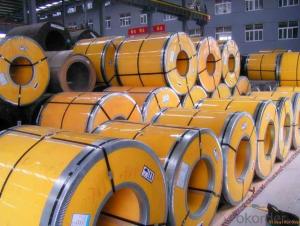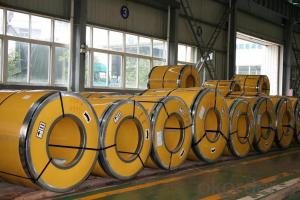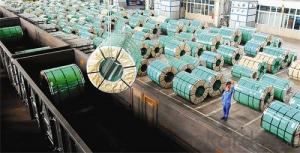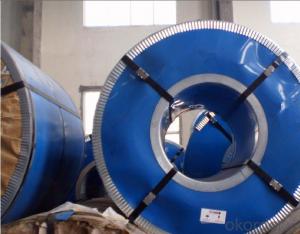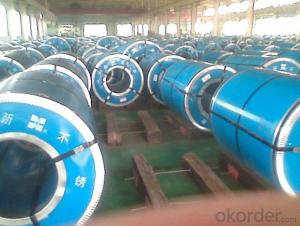Stainless Steel Strip 304 Cold Rolled 2B Finish
- Loading Port:
- Ningbo
- Payment Terms:
- TT OR LC
- Min Order Qty:
- 100 m.t.
- Supply Capability:
- 20000 m.t./month
OKorder Service Pledge
Quality Product, Order Online Tracking, Timely Delivery
OKorder Financial Service
Credit Rating, Credit Services, Credit Purchasing
You Might Also Like
Cold Rolled Stainless Steel Coil 304 Grade 2B Finish
Packaging Detail: standard export packing or as customer's requirements
Delivery Detail: 7-15 days after the order
Standard: | AISI,ASTM,BS,DIN,GB,JIS | Grade: | 304 | Thickness: | 0.3-3.0mm |
Place of Origin: | China Mainland | Brand Name: | CNBM | Model Number: | 304 |
Type: | Steel Coil | Technique: | Cold Rolled | Surface Treatment: | 2B, BA |
Application: | Medical instruments, building, chemical food industry agriculture | Width: | 500-2000mm | Length: | Coil |
finish: | 2B, BA | item: | 304 cold rolled stainless steel coil | density: | 7.93 |
- Q:What are the different types of surface defects in stainless steel strips?
- There are different types of surface defects that can occur in stainless steel strips, which can have an effect on their overall quality, appearance, and performance. Some commonly encountered surface defects in stainless steel strips are as follows: 1. Scratches: These are visible lines or grooves that can be seen on the surface of the strip. They can occur during the manufacturing process, handling, or transportation. Scratches can vary in depth and severity, and if they are deeper, they can potentially impact the corrosion resistance of the stainless steel. 2. Pits: Pitting refers to the formation of small cavities or depressions in localized areas of the strip's surface. Pits can be caused by different factors, such as exposure to corrosive environments, improper cleaning, or manufacturing defects. The presence of pits can compromise the integrity of the stainless steel and make it more susceptible to corrosion. 3. Stains: Stainless steel strips can develop stains or discoloration due to exposure to chemicals, heat, or improper cleaning methods. Stains can range from slight discoloration to more severe, deep stains that are difficult to remove. These defects can affect the appearance of the stainless steel and may also indicate a compromised protective oxide layer. 4. Roll marks: Roll marks are impressions or ridges that appear on the surface of the stainless steel strip during the rolling process. These marks can appear as lines or patterns and are usually caused by uneven pressure or improper alignment of the rolling equipment. Roll marks can impact the aesthetics of the stainless steel and may also affect its mechanical properties. 5. Weld defects: Stainless steel strips that are produced through welding processes can exhibit various types of weld defects, such as weld spatter, incomplete fusion, or excessive penetration. These defects can weaken the joint and reduce the overall strength and corrosion resistance of the stainless steel strip. 6. Surface contaminants: Surface defects in the form of contaminants, such as dirt, oil, grease, or foreign particles, can be present on stainless steel strips. These contaminants can be introduced during manufacturing, handling, or storage, and can have a negative impact on the performance and appearance of the stainless steel. It is important to note that the severity and impact of these surface defects can vary depending on the intended application of the stainless steel strip. Manufacturers implement various quality control measures to minimize these defects and ensure that the stainless steel strips meet the required standards.
- Q:Can stainless steel strips be used in harsh weather conditions?
- Stainless steel strips are capable of withstanding even the harshest weather conditions. Renowned for its outstanding resistance to corrosion, stainless steel is highly impervious to rust and other forms of deterioration caused by exposure to moisture, humidity, and extreme temperatures. Consequently, stainless steel strips prove to be a dependable and long-lasting choice for various applications that experience adverse weather, such as outdoor structures, building facades, roofing, and marine environments. The corrosion resistance of stainless steel can be attributed to the presence of chromium within its composition, which creates a protective layer on the metal's surface, preventing it from reacting with the surrounding environment. Moreover, stainless steel also possesses resistance to UV radiation and can endure strong winds, making it a suitable option for regions prone to storms and hurricanes. In conclusion, stainless steel strips offer an outstanding solution for applications that necessitate strength, durability, and the ability to withstand harsh weather conditions.
- Q:What are the advantages of using stainless steel strips?
- There are several advantages of using stainless steel strips. Firstly, stainless steel is highly resistant to corrosion, making it ideal for applications in environments with high moisture or chemical exposure. Secondly, stainless steel strips have excellent strength and durability, ensuring long-lasting performance. Additionally, stainless steel is easy to clean and maintain, making it a hygienic choice for industries such as food processing or medical equipment. Lastly, stainless steel strips offer a sleek and modern aesthetic, making them suitable for various architectural and decorative purposes.
- Q:What are the common weight tolerances for stainless steel strips?
- The common weight tolerances for stainless steel strips can vary depending on the specific grade and thickness of the strip. However, typical weight tolerances for stainless steel strips range from +/- 5% to +/- 10% of the specified weight.
- Q:How do you determine the corrosion resistance of a stainless steel strip?
- To determine the corrosion resistance of a stainless steel strip, various tests can be conducted. One commonly used method is the salt spray test, where the strip is exposed to a saltwater mist for a specified period. The strip's performance is evaluated by observing any signs of corrosion, such as rust or discoloration. Additionally, electrochemical tests, such as the polarization test or the potentiodynamic scan, can be conducted to measure the strip's corrosion potential and resistance. These tests provide valuable insights into the strip's ability to withstand corrosion in different environments.
- Q:What is the conductivity of stainless steel strips?
- The conductivity of stainless steel strips can vary depending on the specific alloy and composition of the stainless steel. Generally, stainless steel is considered to be a poor conductor of electricity compared to other metals such as copper or aluminum. This is due to the presence of chromium and other alloying elements in stainless steel that impede the flow of electrical current. However, stainless steel still possesses some level of conductivity, albeit lower than metals specifically designed for electrical conductivity. The exact conductivity of stainless steel strips can be determined through conductivity testing or by referring to the specific conductivity values provided by the manufacturer or industry standards.
- Q:Can stainless steel strips be used in the aerospace fasteners?
- Yes, stainless steel strips can be used in aerospace fasteners. Stainless steel is a commonly used material in the aerospace industry due to its excellent corrosion resistance, high strength-to-weight ratio, and ability to withstand high temperatures. Stainless steel strips can be formed into various shapes and sizes to create fasteners such as screws, bolts, nuts, and rivets. These fasteners are crucial for joining different components of an aircraft and ensuring structural integrity and safety. Additionally, stainless steel's non-magnetic properties make it suitable for applications where magnetic interference is a concern, such as in avionics and electronic systems. Overall, stainless steel strips are a reliable and widely used material for aerospace fasteners.
- Q:Can stainless steel strips be used in the medical implants?
- Medical implants can indeed utilize stainless steel strips. This material boasts durability and resistance to corrosion, rendering it appropriate for deployment in medical devices and implants. Commonly, it finds extensive application in orthopedic implants like bone plates, screws, and wires, alongside cardiovascular stents and dental implants. Stainless steel also possesses exceptional biocompatibility, ensuring compatibility with the human body and averting adverse reactions or toxicity. Furthermore, it facilitates straightforward sterilization, a vital aspect for medical implants to prevent infections. Consequently, stainless steel strips constitute a dependable and widely employed substance in the fabrication of medical implants.
- Q:What are the common uses of stainless steel strips in the pharmaceutical industry?
- Stainless steel strips are widely used in the pharmaceutical industry due to their unique properties that make them suitable for various applications. Some common uses of stainless steel strips in the pharmaceutical industry include: 1. Packaging: Stainless steel strips are often used for packaging pharmaceutical products such as tablets, capsules, and powders. They provide a safe and hygienic barrier that protects the medication from external contaminants, moisture, and light. 2. Sterilization containers: Stainless steel strips are utilized in the fabrication of sterilization containers, which are essential for the sterilization process in pharmaceutical manufacturing. These containers ensure that medical instruments, equipment, and supplies are effectively sterilized and maintained in a sterile condition. 3. Mixing and blending equipment: Stainless steel strips are used in the construction of mixing and blending equipment, including containers, tanks, and vessels. These equipment are crucial for the preparation of pharmaceutical formulations, ensuring efficient and consistent mixing of ingredients. 4. Conveyor systems: Stainless steel strips are commonly used in the construction of conveyor systems, which are extensively employed in pharmaceutical manufacturing for the transportation of raw materials, intermediate products, and finished goods. The corrosion-resistant nature of stainless steel makes it ideal for this purpose, as it ensures the cleanliness and purity of the pharmaceutical products during the manufacturing process. 5. Cleanroom applications: Stainless steel strips are utilized in cleanrooms, which are critical in the pharmaceutical industry to maintain a controlled environment free from contaminants. Stainless steel strips are used for fabricating cleanroom furniture, equipment, and fixtures, ensuring a hygienic and durable solution that can withstand frequent cleaning and disinfection. 6. Equipment and machinery components: Stainless steel strips are employed in the manufacturing of various components for pharmaceutical equipment and machinery, such as pumps, valves, fittings, and connectors. The high strength, corrosion resistance, and ease of fabrication of stainless steel make it a preferred material in these applications. Overall, stainless steel strips play a vital role in the pharmaceutical industry by offering a range of benefits, including corrosion resistance, durability, cleanliness, and ease of maintenance. These properties make stainless steel strips an ideal choice for various applications, ensuring the safety, quality, and efficacy of pharmaceutical products.
- Q:What are the common flatness tolerances for stainless steel strips?
- The common flatness tolerances for stainless steel strips vary depending on the specific grade and thickness of the material. However, in general, the industry standard flatness tolerances for stainless steel strips are typically specified as a maximum deviation from a perfectly flat surface. For precision or high-quality stainless steel strips, the common flatness tolerance is often expressed in terms of "bow" or "camber" measurements. Bow refers to the deviation of the strip from a straight line while camber refers to the deviation from a flat surface. The typical flatness tolerance for bow or camber in stainless steel strips can range from 0.5mm to 2mm per meter of length. On the other hand, for standard or commercial-grade stainless steel strips, the flatness tolerances may be slightly higher. It can range from 1mm to 4mm per meter of length. It is important to note that these tolerances are just general guidelines and can vary depending on the specific requirements of a project or application. Additionally, manufacturers and suppliers may have their own specific flatness tolerances based on their capabilities and equipment. It is always recommended to consult the manufacturer or supplier for the exact flatness tolerances for a particular stainless steel strip.
1. Manufacturer Overview |
|
|---|---|
| Location | |
| Year Established | |
| Annual Output Value | |
| Main Markets | |
| Company Certifications | |
2. Manufacturer Certificates |
|
|---|---|
| a) Certification Name | |
| Range | |
| Reference | |
| Validity Period | |
3. Manufacturer Capability |
|
|---|---|
| a)Trade Capacity | |
| Nearest Port | |
| Export Percentage | |
| No.of Employees in Trade Department | |
| Language Spoken: | |
| b)Factory Information | |
| Factory Size: | |
| No. of Production Lines | |
| Contract Manufacturing | |
| Product Price Range | |
Send your message to us
Stainless Steel Strip 304 Cold Rolled 2B Finish
- Loading Port:
- Ningbo
- Payment Terms:
- TT OR LC
- Min Order Qty:
- 100 m.t.
- Supply Capability:
- 20000 m.t./month
OKorder Service Pledge
Quality Product, Order Online Tracking, Timely Delivery
OKorder Financial Service
Credit Rating, Credit Services, Credit Purchasing
Similar products
New products
Hot products
Hot Searches
Related keywords
